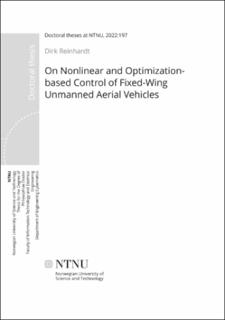| dc.description.abstract | Methods from linear control theory have a considerable share in the state-of-the-art toolbox for control systems engineers when designing autopilots for conventional passenger aircraft. Linear controllers have well-established safety certificates leaning on gain and phase margins of the closed-loop dynamics. Passenger comfort further restricts the operational regime to regions where the aircraft’s dynamics are approximately linear. Similar controller designs are part of the flight-control algorithms onboard small unmanned aerial vehicles (UAVs), for which we have seen increasing use over the past two decades. However, operators often can accept higher risks for low-cost UAVs. Initial experiments have shown that industry-standard linear controllers do not match the agile flight and performance in comparison to manual control of a skilled human pilot. The hypothesis that suitably designed nonlinear controllers can close the performance gap and therefore widen the flight envelope has been the driving motivation for the work described in this thesis.
The text briefly revisits preliminary concepts concerning kinetics and actuation of standard UAVs before continuing with the main contributions in nonlinear flight control. The work results can be summarized as:
A Geometric Attitude Controller with hybrid proportional feedback to track roll and pitch angle references is the subject of the first contribution. We avoid the gimbal lock problem of Euler angles and the unwinding phenomenon of quaternions by designing the control laws directly on the unit two-sphere. The resulting control law steers the attitude dynamics in the direction of the shortest path on the two-sphere towards the reference. With dynamic model inversion, the designed control law achieves almost semi-global exponential stability for time-varying attitude reference signals and almost global asymptotic stability of constant references. A hybrid extension to the proportional feedback results in stronger stability properties with global asymptotic stability regardless of the angular rates and global exponential stability if an additional angular rate condition is satisfied. Simulation studies and experimental results verify the efficacy of this approach.
In a second contribution, we exploit the designed geometric controller and use nonlinear model predictive controller (NMPC) to track roll, pitch and airspeed references. The NMPC generates suitable references for the geometric controller and adds constraint satisfaction and optimal performance.
In a third contribution, different NMPCs are designed with direct access to the actuators of the UAV. As for the geometric controller, the dynamic model of the NMPC uses the Special Orthogonal Group of order Three as attitude representation to avoid the outlined issues of alternative attitude representation and to decrease the nonlinearity of kinematic equations. In contrast to most other aerospace applications using NMPC, the designed controllers are not designed for guidance control with kinematic models and control-augmentation through a low-level proportionalintegral-derivative (PID) controller, but include the full nonlinear kinematic and dynamic equations to control the low-level dynamics of the UAV. To the best of my knowledge the results in this thesis are the first go set the focus on attitude and speed control using NMPC. Simulation studies and experimental verification demonstrate improved performance to industry-standard PID controllers despite harsh weather conditions and significant model inaccuracies.
Considering that the focus of the thesis is on model-based control, we discuss improvements to the dynamic model of the UAV that was part of the experiments. The model identification procedure is based on wind tunnel measurements, including a novel calibration routine for planar symmetry of the airframe. The model from the wind tunnel is augmented with a damping model based on data collected in flight experiments. Cross-validation based on flight data shows significant model improvements compared to the baseline model that was used in the experiments.
As a final result, this thesis includes the design of a NMPC for the path-following problem with direct actuator access. It can be seen as an integrated approach that does not rely on a low-level motion controller, but directly controls actuator setpoints and takes a parameterized path as input. Numerical results show significant performance improvements compared to the other cascaded controllers in the thesis, where an advanced guidance controller sends commands to low-level controllers. | en_US |
